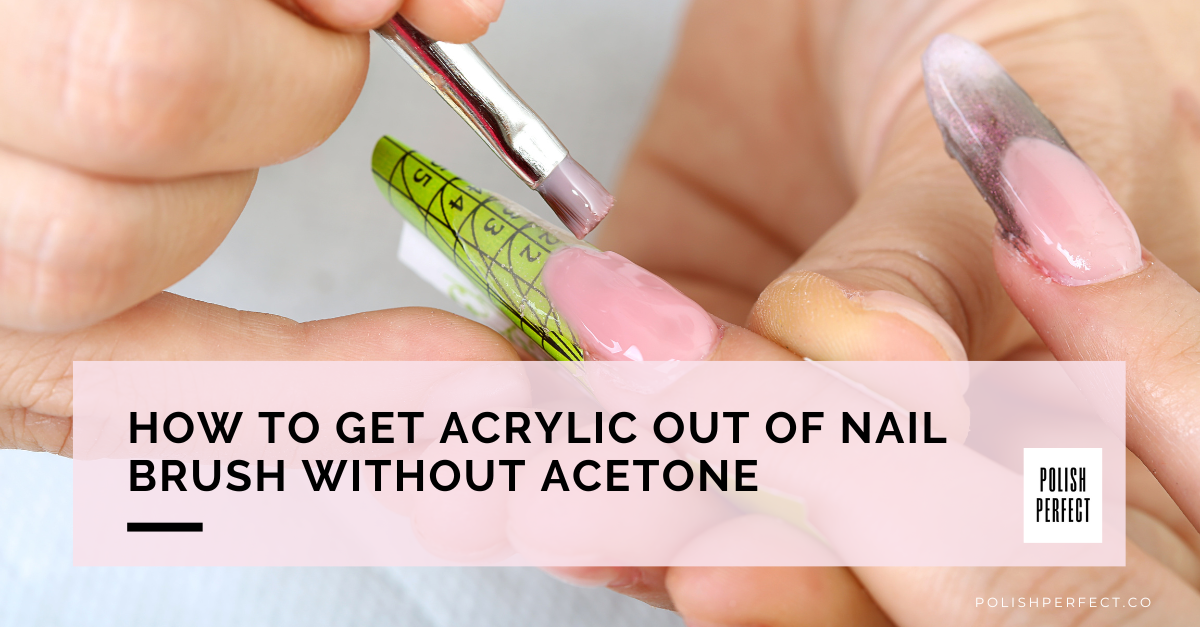You can get acrylic out of nail brushes without using acetone by soaking it in a solution of warm water and a few drops of mild dish soap or hand soap. Gently swirl the brush in the soap solution for a few minutes, then rinse it with clean, warm water.
Acrylic nails need proper care, but cleaning brushes can be tricky.
Frequent acrylic exposure clogs and stiffens bristles. While acetone is common, it can harm brushes.
This article explores ways on how to get acrylic out of nail brush without acetone.
Whether pro or DIY, you’ll find tips to maintain brushes effectively without acetone.
So without further ado, let’s start and get acrylic out of nail brushes!
What is Acetone and Its Uses?
First, let’s talk about acetone.
Acetone is a powerful solvent frequently used in the nail and beauty industry for its ability to dissolve and break down various substances.
It’s most well-known for its usage as a nail polish remover, as it effectively eliminates even the most stubborn polishes.
Moreover, it’s used professionally in salons to dissolve and remove acrylic nails or gel polish, as well as to clean the brushes and tools nail technicians work with.
While acetone is a dream for taking off polish, it does have a downside. It’s known to be quite harsh on your nails, leaving them dry and brittle after prolonged exposure.
That’s why you should always be mindful of how often and how long you’re using acetone on your nails.
If you’re noticing signs of damage, consider giving your nails a break and switching to alternative, gentler removers.
Why Use Acetone?
You might be wondering why acetone is often seen as the go-to solution for cleaning acrylic nail brushes.
From a practical standpoint, using acetone is a quick and easy process.
It’s as simple as soaking your brush in a small container of acetone for a few seconds. This will help loosen and dissolve any acrylic buildup.
Once the acrylic has been softened, gently wipe the brush on a clean, lint-free cloth or paper towel to remove any remaining residue.
This method is more time and effort-efficient compared to other cleaning methods.
However, it’s essential to be mindful of the potential drawbacks of using acetone.
For example, acetone can dry out natural fiber brushes like Kolinsky and Sable, causing them to fray over time.
It’s recommended to clean these brushes with monomer whenever possible to avoid this issue.
Now, let’s talk about the problem: acrylic stuck in nail brushes.
Why Acrylic Can Get Stuck In Nail Brushes?
As a nail tech, you might have encountered this frustrating situation: you’ve just finished creating stunning acrylic nails, only to find your nail brush clogged with dried acrylic.
Acrylic nail products are designed to dry quickly. When you combine the acrylic liquid and powder, a chemical reaction occurs, causing the mixture to harden.
If not cleaned promptly and adequately, the residual acrylic can get stuck in your brushes.
Even tiny bits of leftover acrylic can accumulate over time, hardening the bristles and affecting the quality of your nail applications.
Another factor contributing to acrylic buildup in your brushes is their design. Nail brushes have densely packed bristles, which makes it easier for the acrylic to get stuck between them.
While this dense construction allows for a smooth application and better control when creating your nail masterpieces, it also makes cleaning and maintenance more challenging.
Lastly, consider your work environment. If your workspace is exposed to dust, dirt, or even just air, it can contribute to the acrylic hardening in your nail brush.
Keeping your workspace clean when working on your acrylic nails can minimize buildup in your brushes and keep them in top condition.
Now you know why acrylics get stuck in our brushes, and wouldn’t want to use acetone to clean it due to some harmful effects.
Here are some ways you can do on how to get acrylic out of nail brush without acetone.
Methods On How to Get Acrylic Out of Nail Brush Without Acetone
Acrylic nails can be a fun and creative way to express your style, but they can be a challenge when it comes to cleanup.
Particularly, your nail brushes can quickly become clogged with dried acrylic.
Fear not! There are solutions to clean your brushes that don’t involve acetone.
If you’re looking for methods to clean acrylic nail brushes without using acetone, you’ve come to the right place.
We know that acetone can be harsh on your brushes and your skin, so let’s explore some friendly alternatives that’ll keep your brushes and nails looking fabulous.
1. Using a Brush Cleaner
One way to clean your acrylic nail brushes without using acetone is to opt for a specialized brush cleaner.
Many brands offer brush cleaners specifically designed to gently and effectively clean your brushes without the need for any harsh chemicals like acetone.
Simply follow the manufacturer’s instructions, and watch those brushes become clean and ready to use in no time.
2. Using Warm Water and Soap
If you’re looking for a readily available option, try using warm water and soap to clean your acrylic nail brushes.
Here’s how to do it:
- Dish soap: Mix a small amount of dish soap with warm water in a bowl.
- Soak and agitate: Submerge the bristles of your brush in the solution, and gently agitate them with your fingertips to loosen any trapped acrylic.
- Rinse: Give your brush a good rinse under warm running water, gently squeezing the bristles to remove any remaining soap.
- Pat dry: Using a clean towel or paper towel, gently pat your brush dry.
- Reshape and leave to dry: Reshape the bristles into their original form and leave your brush to air dry.
3. Using Non-Acetone Nail Polish Remover
Lastly, you can also clean your acrylic nail brushes using a non-acetone nail polish remover.
Many non-acetone removers contain more gentle ingredients and can effectively clean acrylic debris without damaging your brushes.
To use non-acetone nail polish remover:
- Pour a small amount: Pour a small amount of non-acetone nail polish remover into a shallow dish or container.
- Soak only the bristles: Carefully dip the bristles of the brush into the liquid, making sure not to let the remover touch the brush’s handle or ferrule.
- Swirl and soak: Gently swirl and agitate the bristles in the remover for a few minutes, then let your brush soak for about 5-10 minutes.
- Remove excess: Using a paper towel or clean cloth, gently wipe the bristles to remove any loosened acrylic residue.
- Rinse and dry: Rinse your brush under warm water to remove any remaining remover and let it air dry.
There you have it, your guide to cleaning acrylic nail brushes without using acetone!
We all know the importance of keeping our nail tools clean and well-maintained, so here’s a detailed article on how to clean your acrylic nail brush for more details.
Give these methods a try, and remember to clean your brushes regularly to keep them in tip-top shape!
Should You Use Acetone To Clean Acrylic Nail Brushes?
As a nail enthusiast, you’re well-familiar with all the essentials in your nail toolkit – including the beloved nail brush.
And why wouldn’t you be? It’s hard to imagine perfect nails without the assistance of these humble helpers.
However, every now and then, acrylic can build up in your nail brush making it clumpy and unusable.
You might be tempted to reach for acetone to clean it up, but wait just a moment!
Although acetone is famous for its nail polish-removing abilities and can work wonders when it comes to cleaning brushes with synthetic fibers, it might not always be the best choice for your nail brush.
Take a closer look at the bristles of your nail brush. If your brush sports natural hair bristles, such as those from Kolinsky or Sable, hold back from using acetone.
These fibers are more delicate and can be damaged – dried, frayed, and ruined – by the harshness of acetone.
But fear not, there’s an alternative for these delicate beauties: reach for monomer instead! It’s a gentle soul and is highly recommended for cleaning natural bristle brushes.
On the other hand, if your brush bristles are made from synthetic fibers, you’re in luck!
Acetone can safely be used to dissolve acrylic build-up and restore your brush to its former glory.
Just make sure to avoid soaking the brush’s body in acetone – focus on the bristle tips only.
In short, acetone can be your friend when trying to get acrylic out of nail brushes, but only if those brushes are made from synthetic fibers.
For natural hair bristle brushes, give monomer a try, and show your tools some love.
How To Get Acrylic Out of Nail Brush Without Monomer?
Cleaning your acrylic nail brushes without monomer can seem tricky at first, but don’t worry! There are alternative methods to keep those brushes in tip-top shape.
Let me break it down for you.
First, start by gently wiping off any excess acrylic from the brush while it’s still wet.
Acrylic is easier to clean while it’s soft, and dried acrylic can stick to the bristles, making things more complicated.
Use a lint-free paper towel or cotton pad to remove excess acrylic, keeping the bristles as clean as possible.
Now, let’s dive into the alternatives to monomer for cleaning your brushes. One popular option is using a specially-made brush cleaner.
These products are designed specifically for cleaning acrylic nail brushes and are a great investment for keeping your brushes in pristine condition.
Just follow the instructions on the label, and your brushes will thank you.
Frequently Asked Questions
What household items can effectively Get acrylic Out Of nail brushes?
Rubbing alcohol, also known as isopropyl alcohol, can be an effective household alternative for removing acrylic from nail brushes.
Additionally, a mixture of warm water and mild dish soap or hand soap is another option to get acrylic out of nail brushes, although it may not be as potent as using a solvent.
Any Natural Alternatives How To Get Acrylic Out of Nail Brush Without Acetone?
Natural alternatives that can be used for get acrylic out of nail brushes include using a mixture of warm water and a few drops of dish soap, hand soap, or even a gentle shampoo.
Although not as powerful as solvents like acetone or rubbing alcohol, these natural options may still provide some level of effectiveness get acrylic out of nail brushes.
How To Maintain And Condition My Nail Brush After Removing Acrylic?
To maintain and condition your nail brush after removing acrylic, it is essential to clean and rinse the brush properly.
After cleaning, gently reshape the bristles and let it air dry completely. Avoid using direct heat (like a blow dryer) to dry the brush, as it can damage the bristles.
To extend the life of your brush, store it with the bristles pointing up or suspended, so they don’t bend or get misshapen.
Final Thoughts
To keep your brush in top shape, clean it regularly during and after use.
Now that you’ve gained the knowledge on how to get acrylic out of nail brush without acetone, your nail game will remain at its best.
Happy nail art-ing!
If you found this guide helpful, please consider sharing it on social media or leaving your thoughts in the comments below.



